99% Tariff Elimination, Stronger Bilateral Trade, Catalyst for Inclusive Growth
Posted On: 27 JUL 2025 11:23AM
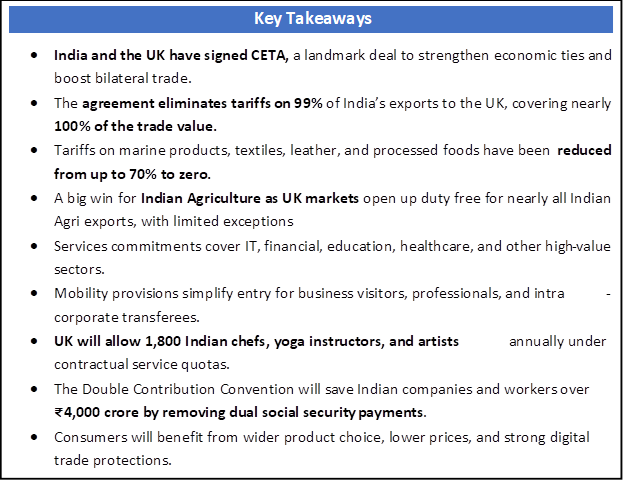
Introduction
India and the United Kingdom have signed the Comprehensive Economic and Trade Agreement (CETA), a bilateral free trade agreement marking a major milestone in their longstanding partnership. The agreement was signed by Commerce and Industry Minister Shri Piyush Goyal and UK Secretary of State for Business and Trade Mr. Jonathan Reynolds in the presence of Prime Minister Shri Narendra Modi and UK Prime Minister Sir Keir Starmer. This follows the successful conclusion of negotiations announced on May 6, 2025, and reflects the shared ambition of two major economies to deepen economic ties. Bilateral trade has already reached USD 56 billion, with a target to double this by 2030.
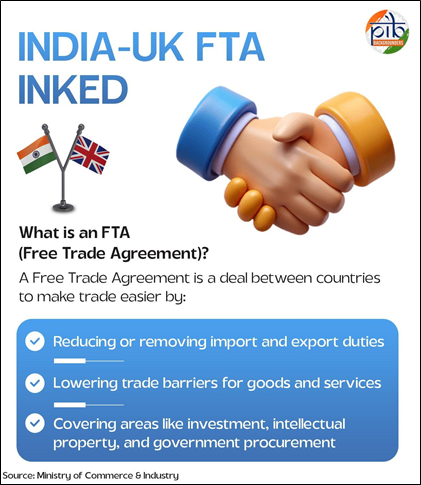
- India-UK bilateral annual trade ~USD 56 billion
- Total merchandise-trade ~ USD 23 billion
- Total services trade ~ USD 33 billion
CETA provides an unprecedented duty-free access to 99 per cent of India’s exports to the UK, covering nearly 100% of the trade value. This includes labour-intensive sectors such as textiles, leather, marine products, gems and jewellery, and toys as well as high-growth sectors like engineering goods, chemicals, and auto components. This will spur large-scale employment generation, empowering artisans, women-led enterprises, and MSMEs. The agreement includes a wide-ranging package covering Information Technology /IT enabled services, financial and professional services, business consulting, education, telecom, architecture, and engineering that will unlock high-value opportunities and job creation.
The agreement goes beyond goods and addresses services, a core strength of India’s economy. India exported over USD 19.8 billion in services to the UK in 2023, and CETA promises to expand this further In a first by UK, mobility for professionals across IT,
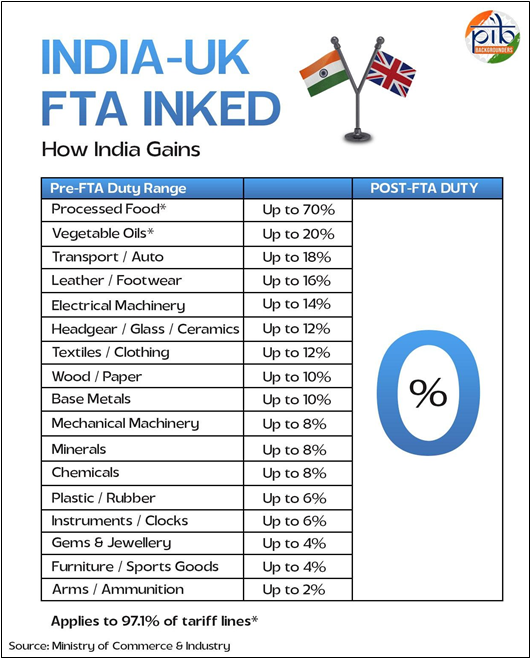
healthcare, finance, and education is being eased with CETA providing for streamlined entry for Contractual Service Suppliers, Business Visitors, Intra-Corporate Transferees, Independent Professionals (e.g., yoga instructors, chefs, and musicians). Another major breakthrough is the Double Contribution Convention that will save Indian firms and workers more than INR 4,000 crore by removing the need for dual social security contributions.
With measures that promote mobility, innovation, and inclusivity, CETA is expected to create jobs, boost exports, and strengthen India–UK economic resilience.
In words of the Commerce and Industry Minister, Shri Piyush Goyal – “This FTA will serve as a catalyst for inclusive growth, benefiting farmers, artisans, workers, MSMEs, startups, and innovators while safeguarding India’s core interests and accelerating our journey towards becoming a global economic powerhouse.”
India has opened 89.5 % of its tariff lines, covering 91 % of UK’s exports, safeguarding sensitive sectors and strategically important products where domestic capability is being built. Elimination of duties will make a range of imported products more affordable for consumers, offering greater variety and quality at competitive prices.
Key Features of the Agreement

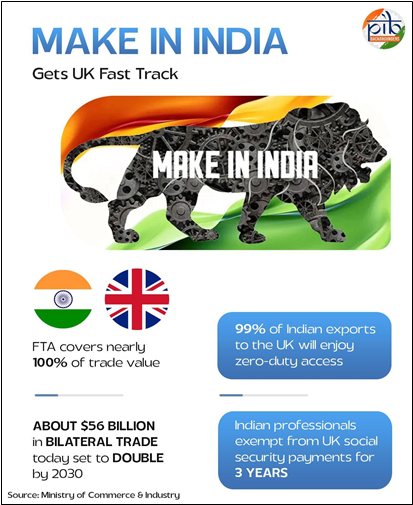
The India–UK Comprehensive Economic and Trade Agreement (CETA) is designed to open new avenues for trade and investment, while protecting India’s core economic interests. It combines tariff reduction, simpler rules for trade, strong provisions for services, and measures that make professional mobility easier.
Comprehensive Tariff Elimination
CETA ensures tariff elimination on about 99 per cent of tariff lines, covering India’s nearly entire trade basket. This means nearly 100 percent of Indian goods such as textiles, leather, marine products, gems and jewellery, toys, chemicals, engineering products, chemicals, agri- products will enter the UK market at zero duty.
At the same time, India has opened 89.5 % of its tariff lines covering 91 % of UK’s export. Only 24.5 % of UK’s export will enjoy immediate duty free market access. India has safeguarded sensitive sectors like dairy, cereal, millets, pulses, certain essential oils, apples, certain vegetables, gold, jewellery, lab grown diamonds. Strategic exclusions also cover critical energy, fuels, marine vessels, some polymers, worn clothing, smart phones, optic fibres . For strategically important products where domestic capacity is being built, for example under Make in India or PLI, India will provide gradual tariff reduction over 5, 7 or 10 years. India has gradually and selectively opened her markets to alcoholic beverages.
Bilateral safeguards have been built in to manage any sudden import surges that could harm domestic industries.
Simplified Rules of Origin
The agreement simplifies compliance by allowing exporters to self-certify the origin of products, reducing time and paperwork. UK importers can also rely on importers’ knowledge for certification, further easing trade. For small consignments under £1,000, there is no requirement for origin documentation, which supports e-commerce and small businesses. Product Specific Rules of Origin (PSRs) align with India’s current supply chains for key sectors such as textiles, machinery, pharmaceuticals, and processed food.
Boost for Services and Professional Mobility
Services are a core strength of India’s economy, and the agreement provides deeper market access across IT, financial services, education, and healthcare. It also creates a structured framework for the temporary movement of professionals. Business visitors, contractual service suppliers, and independent professionals can now access the UK under clear and predictable entry rules. Additionally, up to 1,800 Indian chefs, yoga instructors, and classical musicians can work in the UK every year under these provisions.
Double Contribution Convention
A key innovation in the agreement is the Double Contribution Convention (DCC). This exempts Indian workers and their employers from paying UK social security contributions for up to three years when on temporary assignments. Around 75,000 workers and over 900 companies are expected to benefit, resulting in savings of more than INR 4,000 crore.
Sector-Wise Gains Under CETA
The India–UK Comprehensive Economic and Trade Agreement unlocks unprecedented opportunities across a wide range of industries. With tariffs removed on nearly 99 per cent of tariff lines, Indian exporters now enjoy duty-free access in key sectors such as agriculture, food processing, textiles, engineering goods, chemicals, pharmaceuticals, marine products, and electronics. This not only enhances competitiveness but also reduces compliance costs and accelerates access to the UK market.
Agriculture and Allied Goods
- Zero Duty Market Access: The agriculture sector accounts for 1,437 tariff lines, which constitutes 14.8% of all product tariff lines. This indicates a significant presence of agriculture in the trade structure, reflecting the diversity and importance of agri-based goods in tariff regulation. Food Processing accounts for 985 tariff lines, the sector holding a 10.1% share.
- Agricultural exports from India were valued at USD 45.05 billion in 2022-23, a rise from USD 41.3 billion in 2020-21 (APEDA).
- In agriculture, India exports USD 36.63 billion globally, while the UK imports USD 37.52 billion, but imports just USD 811 million from India, revealing room for growth in high-value agri products.
- The UK is a high-value market for niche Indian agri-products such as tea, mangoes, grapes, spices, marine products, etc.
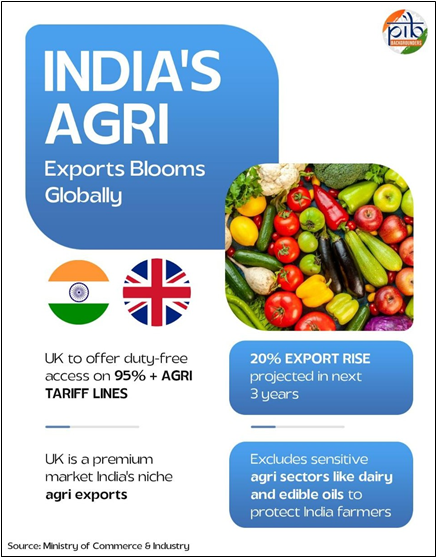
- The India-UK CETA will allow Indian farmers to fetch premium prices for these products in the UK market.
- India exports USD 14.07 billion processed food products globally, while the UK imports USD 50.68 billion, but Indian products make up just USD 309.5 million.
- India-UK CETA is expected to have a significant positive impact on the Indian agricultural and processed food sector, with exports of agri and processed food products exports expected to rise by over 50% in the next 3 years.
- Significant Market Benefits: The India-UK FTA will deliver a seismic shift bringing Indian products at parity with major agri exporters such as EU, South Africa, Turkey, Canada, Peru, Vietnam which currently enjoyed zero/concessional duty access
- India's Competitive Edge Sharpened. The FTA will strategically position India to outcompete major global players in crucial segments:
-
- Fresh Grapes: Outmanoeuvring Brazil and matching top exporters like Egypt and South Africa.
- Processed Food Preparations: Gaining ground over the US, China, and Thailand.
- Bakery Items: Becoming more competitive than the US, China, Thailand, and Vietnam.
- Preserved Vegetables, Fruits, and Nuts: Advancing against Turkey, Pakistan, South Africa, and China.
- Fresh/Chilled Vegetables (NES): Outperforming the US, Brazil, Thailand, and China.
- Sauces and Prepared Sauces: Better positioned against the US, Japan, Thailand, China, and Malaysia
-
- States like Maharashtra (grapes, onions), Gujarat (groundnut, cotton), Kerala (spices), and NE states (horticulture) stand to benefit.
-
- State-specific agri-export plans (APEDA) already align with FTA goals, ensuring equitable regional benefits from enhanced UK market access.
- Exponential Growth Potential: UK already represents a significant market for India, absorbing 1.7% of coffee, 5.6% of tea, and 2.9% of spice exports – now primed for exponential growth with duty free access on these products.
- Level Playing Field: Duty-free access on instant coffee will help Indian businesses compete with other European suppliers of Instant/value added coffee such as Germany, Spain, Netherlands.
- Strong Opportunity for Value Added Products: FTA will create a powerful springboard for boosting exports of value-added coffee products particularly Indian instant coffee to the UK.
Indian Oilseeds and Produce Export Promotion Council
- Potential for Market Expansion: UK market can provide a new avenue for Indian Oilseed exporters to reach a broader consumer base and expand their market share.
- Enhanced Competitiveness: With reduced tariffs and streamlined procedures, Indian Oilseed exporters can become more competitive in the UK market, potentially leading to higher exports.
- India exported marine products worth USD 8.09 billion in 2022–23, with fish, shrimp, and cuttlefish among the top categories.
- The UK is a high-value consumer of Indian frozen seafood, especially shrimp and white fish, due to the large Indian diaspora and demand for processed seafood.
- The CETA eliminates UK tariffs, improving the price realization for Indian exporters, benefits that flow down to coastal fisherfolk through higher procurement rates.
- According to MPEDA, seafood processing plants employ thousands of women workers, and increasing UK market access can double capacity utilization.
- Coastal states like Kerala, Andhra Pradesh, Gujarat, Tamil Nadu, and Odisha stand to benefit significantly from export-led job creation.
- Untapped Export Opportunity: Despite the UK’s USD 5.4 billion marine import market, India’s share remains at just 2.25%, underscoring a significant untapped export opportunity.
- FTA as a Growth Catalyst: With existing UK tariffs on Indian shrimp ranging between 4.2 – 8.5%, the FTA’s tariff elimination are expected to unlock rapid growth, particularly in shrimp, tuna, fishmeal, and feeds.
- Momentum in Value-Added Exports: Exports under Chapters 03 and 16 (value-added seafood) rose by 3.5% in FY 2024–25. The FTA incentivizes higher-value processing and product diversification.
- Zero Duty market access for the textiles and clothing sector accounts, down from the earlier 12 % duty . This accounts for 1,143 tariff lines, contributing 11.7%.
- Dismantles Duty Disadvantage: India facing duty disadvantage vis-à-vis Bangladesh, Pakistan and Cambodia, which had duty free access to UK market. The FTA eliminates the tariff on textile imports from India, thereby enhancing our competitiveness.
- In textiles and clothing, while the UK's total imports (USD 26.95 billion) are lower than India's global exports (USD 36.71 billion), India still supplies only USD 1.79 billion to the UK. With the FTA promising duty-free access and removal of trade barriers, this sector is also well-positioned to increase its footprint. Overall, the data underscores a clear export potential gap that the FTA can help bridge, enhancing India’s presence in one of the world’s most lucrative import markets.
- Sectors Poised for Exponential Growth: include RMG, Home Textiles, Carpets, and Handicrafts, where the removal of duties creates immediate and substantial competitive advantages.
- Strategic Market Positioning: As the UK's fourth-largest textile supplier, India, currently holding a 6.1% market share, is now empowered to aggressively close the gap with leading players like China and Bangladesh.
- Production hubs such as Tirupur, Surat, Ludhiana, Bhadohi, and Moradabad will benefit from increased demand, fostering job creation and economic growth.
Leather & Footwear Products
- Total exports of leather and footwear from India are more than USD 5 Bn. Current Indian export to UK is USD 440 Mn. India-UK CETA opens up USD 8.5 Bn leather and footwear export market for Indian exporters.
- 0% duty has been granted for export from India to UK for Leather, Leather and Synthetic Products, Fur and fur products and Footwear and Footwear Components. Products in this category earlier faced duties of up to 16%.
- Additional Market Share: India is expected to gain at least 5% additional market share in the UK within 1 to 2 years.
- Outperform Competitors: FTA positions India to outperform competitors like Vietnam, Indonesia, Cambodia, Turkey and Bangladesh, particularly in the value-conscious UK retail and brand segment.
- Export Boom: Conservative estimates project exports of leather goods and footwear from India to the UK could exceed USD 900 million, marking a substantial leap forward.
- Vision for Dominance: In the longer run, India is well-positioned to become one of the top three suppliers to the UK in these sectors.
- The manufacturers and exporters from many states such as Uttar Pradesh, Tamil Nadu, West Bengal and Delhi NCR stand to gain substantially
- Zero Duty Market Access: The engineering goods sector has the highest share among the listed sectors with 1,659 tariff lines, making up 17.0% of the total. This indicates a broad variety of engineering-related items—machinery, components, and equipment—under tariff coverage, underscoring its importance in industrial and trade dynamics.

- Importance of UK for India’s Engineering Goods: UK is India's 6th largest engineering export market; strong trade momentum with growth of 11.7% in 2024-25 over the previous year.
- Engineering goods reflect one of the widest gaps: India’s global exports are USD 77.79 billion, while the UK imports USD 193.52 billion worth of such products, yet only USD 4.28 billion comes from India—signalling strong potential for expansion.
- Doubling of Engineering Exports: With tariff elimination (as high as 18%) under the FTA, engineering exports to the UK could nearly double in the next five years reaching over USD 7.5 billion by 2029-30.
- This directly supports India’s broader target of achieving USD 300 billion in engineering exports by 2030, solidifying the UK’s position as a critical partner.
- Support to MSMEs in Iron & Steel: Zero tariffs boost MSME exports by improving price competitiveness and enabling scale-up.
- Duty-Free Access for Machinery: facilitates deeper integration of MSMEs into UK’s advanced manufacturing supply chains, especially in sectors like renewable energy, automotive electronics, and industrial automation.
- Push for Aerospace & Defence: Full liberalization supports exports and “Make in India” initiative
- Healthy Growth Projections: Export of key engineering products like electric machinery, auto parts, industrial equipment, and construction machinery projected to grow at 12–20% CAGR.
- Catalyst for Achieving the Target: The FTA supports India’s broader target of achieving USD 300 billion in engineering exports by 2030, solidifying the UK’s position as a critical partner.
- Electronics Exports to Scale New Heights: Zero-duty access expected to accelerate exports of electronic products, with smartphones, optical fiber cables, and inverters set to strengthen India’s foothold in UK market.
- Robust Software Services Growth: Ambitious UK commitments for Software and IT-enabled Services to unlock new markets, drive job creation, and enhance export potential for Indian software firms; 15-20% annual growth projected (Current: USD 32 Bn in 2024-25).
- Advancing Goal of Digital Economy: Competitive access for software development and network infrastructure likely to fuel growth in digital trade.
Electronics and Telecom Exports
- India's 4th largest export market; growth of 25% in 2024-25 over previous year. In CY 2024, India’s global exports USD 35 billion (UK 2 B). UK total imports USD 78 Billion.
- UK’s duty free access from Day 1 opens substantial export opportunities for Indian electronics, especially TV, monitors, Telecom equipment, inverters. Our major competitors are China & USA.
- Includes provisions for recognition of Indian conformity assessment bodies, allowing electronics & telecom products tested in India to be accepted in the UK.
- Exports to double in five years to USD 4 billion by 2030.
- States to gain: Tamil Nadu, Karnataka, UP, Maharashtra, Gujarat Imports, India has strategically protected high-volume domestic products such as smartphones, smartwatches and telecom gear by excluding them from tariff elimination. Key intermediate inputs like battery parts have been liberalized to support India’s manufacturing ambitions
- Zero Duty Market Access: The pharma sector has only 56 tariff lines, which is just 0.6% of the total. Despite its relatively small representation in terms of tariff lines, the pharmaceutical sector typically holds high value and strategic importance, especially in global trade.
- Pharmaceuticals present another high-potential area: India exports USD 23.31 billion globally and the UK imports nearly USD 30 billion, but Indian pharma accounts for under USD 1 billion, indicating significant headroom for growth.
- Generics gets the Sweet Medicine: The zero tariff provisions under the FTA are expected to significantly enhance the competitiveness of Indian generics in the UK market, which remains India’s largest pharmaceutical export destination in Europe.
- Medical Devices Devoid of Duty Clutches: Significant share of medical devices like surgical instruments, diagnostic equipment, ECG machines, X-Ray systems will not attract any duty. This will reduce costs for Indian med-tech companies and make their products more competitive in the UK market.
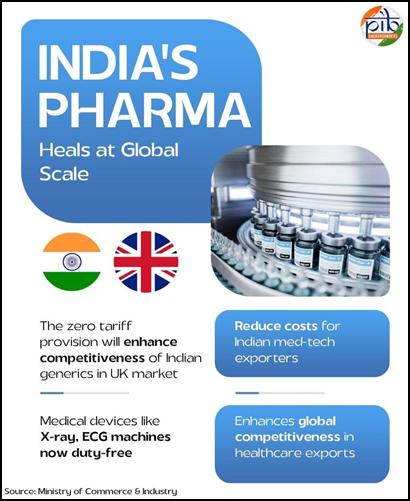
- Strategic Market Positioning: Given the UK’s shift away from reliance on Chinese imports post-Brexit and COVID-19, Indian manufacturers are poised to emerge as a favoured, cost-effective alternative, especially with zero-duty pricing for medical devices.

Medical Devices
- Medical devices and instruments will be exported to the UK at zero tariffs from current 2% - 6% tariff levels, helping Indian manufacturers of surgical and diagnostic equipment.
- India’s global exports are USD 2.2 billion . India’s current exports to UK are USD 37 million
- UK represents a huge opportunity for the Indian Medical device manufacturers with UK’s Medical devices market size was estimated to USD 32 Billion in 2024 and expected to reach to USD 69 Billion by 2035 with CAGR of 7.19%.
- Expand Market share viz a viz global competitors like China, Brazil, Vietnam etc. who face MFN Tariffs by become more price competitive.
- CETA incorporates a mutual recognition agreement framework whereby medical devices certified by Central Drugs Standard Control Organisation (CDSCO) or the Indian Certification of Medical Devices (ICMED) can access the UK markets more freely.
- Zero Duty Market Access: With 1,206 tariff lines, the chemicals and allied sector contributes 12.4% to the total. This includes products like fertilizers, industrial chemicals, and petrochemicals, emphasizing its substantial role in trade classification and policy.
- Opportunity: Duty-free access opens doors to the UK’s USD 28.35 Bn chemicals market for Indian exporters.
- Competitive Edge: In 2024, the UK’s main sources of chemical imports were the US, China, Germany and France. With full and immediate tariff elimination, CETA positions India as a competitive, reliable supplier and a strong alternative to existing sources.
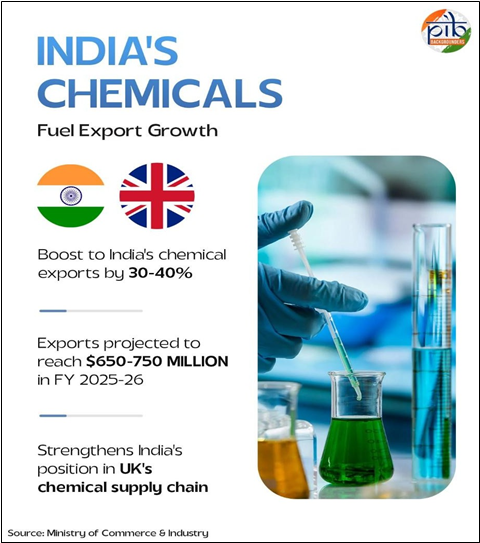
- Boost for Indian Exporters: With the immediate and full tariff elimination for Inorganic Chemicals, Organic Chemicals, Agrochemicals etc will improve the price competitiveness of these Indian chemical products in the UK market, leading to enhanced exports
- Projected Export Growth: The India-UK CETA is anticipated to trigger around 30%- 40% increase in India's chemical exports to the UK (an estimated USD 650-750 million for the year 2025-26).
- Significant Export Potential: India’s current position as the 13th largest plastic supplier to the UK, duty free access presents opportunity to tap into the UK’s robust demand for plastics—films, sheets, pipes, packaging, tableware, and kitchenware—segments where India has proven manufacturing strength. India’s exports to UK in FY 2024-25 were around USD 0.509 Bn with top products including Flexible Intermediate Bulk Containers (FIBC); Optical Fibres Optical Fibre Bundles & Cables; Sacks &Bags; Decorative Laminates and Plates, Sheets, Film, Foil and Strip, etc.
- Exports are expected to grow further with the enhanced, duty free access under the CETA and are projected to reach around USD 800 Mn over next 3 years.
- Competitive Edge: Duty Free Access allows India to better compete with UK’s major import sources such as Germany, China, the United States, the Netherlands, Belgium, and France.
- Increased Commercial Appeal: Lower landed costs are expected to enhance the commercial appeal of Indian goods in UK retail and distribution channels.
- Pivotal Opportunity to Enhance Exports: Projected growth is 15% and the target for next 5 years for the calendar year 2030 is USD 186.97 Mn. Exports of soccer balls, cricket gear, rugby balls, and non-electronic toys set to increase.
- FTA giving Competitive Edge: Indian sports goods and toys will benefit from eliminated UK import duties, making them more price-competitive compared to countries like China or Vietnam, which do not have similar FTAs with the UK.
- Enhanced Alignment with UK Safety Standards: Will promote compliance with UK and EU standards, thereby increasing buyer confidence and mutual collaboration.
Steel and Products of Iron and Steel
- The immediate and full tariff elimination (zero tariff) where tariffs were previously as high as 10%, for iron and steel products is poised to significantly benefit India’s ferrous sector, particularly its large base of MSMEs.
- The UK steel market size was approximately US$ 32.13 billion in 2024, and is projected to reach US$ 42.74 billion by 2033.
- Tariff Elimination Advantage: Both categories now face 0% tariffs under the UK offer. This creates a level playing field and opens up price competitiveness for Indian exporters.
- Export Potential vs. UK Demand: Combined UK import demand for these categories is $18.46B. India currently supplies only $887 M, which is ~4.8% of UK’s total import demand. Even capturing 30–40% of UK’s import share could push exports close to the $7.5B target.
- India’s Global Export Capacity: India exports $22.36B globally in these categories. Redirecting just ~33% of global exports to the UK could meet the target.
- Duties slashed from around 4 % to 0
- Unleash Huge Market Potential: India’s total G&J exports to UK are valued at USD 941 million, with USD 400 million coming from Jewellery. The FTA opens up huge market as UK imports approximately USD 3 billion worth of Jewellery annually.
- Boosting Exports: Tariff relaxations under the FTA are projected to double India’s gems and Jewellery exports to the UK within the next 2-3 years.
- Supports Livelihood and Craftsmanship: The trade boost will generate substantial employment opportunities in India’s design, manufacturing, and artisan sectors, and invigorate traditional craftmanship, fostering inclusive economic growth.
Gains in the Services Sector
The services sector is the largest contributor to India’s economy, accounting for 55 per cent of Gross Value Added (GVA), while the UK’s services sector accounts for 81 per cent. India enjoys a trade surplus of around 6.6 bn USD with UK- Exports of 19.8 bn and imports of 13.2 bn. UK has provided comprehensive and deep market access in 137 sub-sectors. Best FTA plusThe India–UK Comprehensive Economic and Trade Agreement (CETA) creates one of the most ambitious service trade packages in any FTA signed by the UK, opening major opportunities for businesses and professionals.
Comprehensive Market Access
India has secured wide-ranging commitments from the UK, covering all 12 major service sectors and 137 sub-sectors, which represents over 99 per cent of India’s export interests. These include key areas such as IT and IT-enabled services, financial services, education, healthcare, professional services (accountancy, engineering, and management consultancy), telecommunications, and aviation support services.
Ambitious UK commitments in digitally delivered services will enable:-
● continued robust growth in IT and Business Services to expand pie (from 14 bn USD) in around 200 bn USD imports of UK.
● Indian start-ups to enter the UK market with reduced compliance friction and appeal to a wider customer base
● support the expansion of GCCs that serve U.K.-headquartered businesses
On the Indian side, commitments have been extended in 108 sub-sectors, granting UK firms access to domains like accounting, auditing, financial services (with FDI capped at 74 per cent), telecom (100 per cent FDI allowed), environmental services, and auxiliary air transport services. UK companies can now provide telecom, construction, and related services in India without establishing a local presence, enjoying full national treatment, meaning they will be treated on par with Indian firms.
India’s market access in areas such as Professional Services, Business Services, Financial Services and Environmental Services will :-
● Facilitate investments into India
● bring technology and competitiveness
● Potential to serve global markets
Mutual Recognition and Professional Mobility
Both countries have agreed to pursue Mutual Recognition Agreements (MRAs) for professional qualifications within 12 months of the agreement’s entry into force, targeting fields like nursing, accountancy, and architecture. This will reduce barriers for professionals and facilitate the exchange of best practices.
For Indian professionals, the UK has provided an assured regime for temporary entry and stay in categories such as Business Visitors, Intra-Corporate Transferees, Contractual Service Suppliers, Independent Professionals, and Investors. Durations range from 90 days for business visitors to 3 years for intra-corporate transferees, with the possibility of extensions:
• Business visitors (BV) for all sectors- 90 days in any 6 months period;
• Intra- Corporate Transferees (ICT) for all sectors including partner and dependent- 3 years; also provided for Graduate Trainees
• Investors- 1 year;
• Contractual Service Suppliers (CSS)- 12 months in any 24 months; 33 sub sectors (IT/ITes, Business, finance, hospitality, transport etc)
• Independent Professionals- 12 months in any 24 months, 16 sub sectors (IT/ITES, Business, professional, telecom, finance etc)
• Agreed to not impose numerical restrictions or Economic Needs Test requirements.
Importantly, no Economic Needs Test (ENT) is required, and no numerical restrictions will be placed on professionals travelling to the UK for work. The perceived risk of encountering ENTs has often discouraged businesses from seeking overseas talent, limiting the potential benefits of labour mobility provisions. This assurance under CETA will remove uncertainty and encourage smoother movement of professionals.
A dedicated quota of 1,800 positions annually is reserved for Indian chefs, yoga instructors, and classical musicians under contractual service supplier arrangements, reflecting recognition of India’s cultural expertise.
Double Contribution Convention
A landmark feature of this agreement is the Double Contribution Convention (DCC). Previously, Indian employees and their employers had to pay nearly 20 per cent of salaries to the UK’s National Insurance system during short-term assignments without receiving any benefits in return. As mentioned earlier, under the DCC, such dual contributions are eliminated for stays of up to 36 months, benefiting more than 75,000 Indian professionals and 900 companies. Industry estimates suggest this will result in annual savings of over USD 500 million, significantly improving the competitiveness of Indian firms operating in the UK.
Digitally Delivered Services and Investment Opportunities
The UK has provided significant commitments for digitally delivered services (Mode 1), including IT, professional consultancy, education and training, and telecom services. This is a big boost for India’s IT/ITES sector, which already enjoys a trade surplus with the UK. Commitments under Mode 3 (commercial presence) also create opportunities for Indian service providers to invest in the UK in fields such as management consultancy, education, and environmental services.
Sector-Wise Service Benefits Under CETA
From IT and financial services to healthcare, education, and start-ups, India–UK Comprehensive Economic and Trade Agreement provides market access, reduces barriers, and promotes collaboration. These commitments are designed to strengthen trade, drive innovation, and create jobs while ensuring both economies leverage their core strengths.
Information Technology and IT-Enabled Services
The UK has taken full commitments in Computer and Related Services, giving certainty to Indian businesses planning to invest in the UK. This will strengthen the UK’s role as a key market for Indian IT companies and encourage further expansion. Reduced compliance costs and simplified processes will make operations easier for Indian firms, improving their efficiency and competitiveness.
The agreement can deepen collaboration between Indian IT firms and UK small and medium enterprises. UK businesses will benefit from India’s expertise and cost-effective solutions in areas like digital transformation and cloud services.
Mobility-related commitments will have a significant impact, making it easier for Indian IT professionals to work in the UK. Combined with the Double Contribution Convention (DCC), these changes will allow seamless and cost-effective talent movement. This is expected to drive collaboration in emerging technologies like fintech, artificial intelligence, and data analytics. Large IT players will gain from bigger contracts, while niche firms will benefit from innovation-focused partnerships.
Global Capability Centres
The agreement aligns with India’s goal of becoming a global hub for high-value services. Greater UK investment and cooperation will boost India’s digital economy and skilling initiatives. For the UK, the deal offers access to one of the world’s fastest-growing technology markets.
This agreement could shift UK companies’ approach to India—from a low-cost back-office destination to a strategic partner for research and development, analytics, cybersecurity, and emerging technologies. It will also support the growth of Global Capability Centres (GCCs) that serve UK-based businesses or deliver global services from India. India already hosts over 1,700 GCCs employing more than 1.9 million people, driving digital transformation for leading multinational companies.
Start-up Ecosystem
India’s start-up ecosystem, with over 150,000 companies, will benefit from easier market access to the UK. The agreement reduces compliance hurdles, helping Indian start-ups reach new customers, especially in digital services. For Indian start-ups already operating in the UK, the DCC brings financial and operational advantages, making cross-border scaling simpler and more cost-effective.
Health and Education Services
The agreement opens new opportunities for collaboration in health and education. UK’s commitments in private healthcare and education, combined with India’s offers in these sectors, create space for strong partnerships. Indian hospitals can work with UK counterparts to deliver better healthcare and adopt advanced medical technologies.
UK educational institutions will be able to establish campuses in India, while Indian institutions can set up operations in the UK and expand in areas such as EdTech. The deal also benefits highly skilled Indian medical professionals, who already play a vital role in the UK’s National Health Service. Provisions on mutual recognition agreements will further smoothen their entry into the UK workforce.
Financial Services
The agreement encourages UK investment in India’s fast-growing financial market, which can introduce innovative and competitive services while maintaining sectoral stability. Indian financial firms will gain better access to the UK, improving their ability to serve the Indian diaspora and businesses there.
Non-discrimination rules guarantee fair treatment for Indian firms, while transparency commitments ensure UK regulations remain objective and clear. The agreement is also expected to support the growth of electronic payments, fintech, and other digital financial solutions, strengthening overall market integration.
India Protects what Matters
- India has safeguarded its sensitive sectors—dairy, cereals and millets, pulses, and vegetables to high-value items like gold, jewellery, lab-grown diamonds, and certain essential oils, critical energy fuels, marine vessels, worn clothing, and critical polymers and their monofilaments, smart phones, optical fibres — a strong stand to protect farmers, MSMEs, and national interests.
- India has opened 89.5% of its tariff lines, covering 91% of the UK’s exports. 24.5% of the UK’s export value will enjoy immediate duty-free market access.
- Strategically important products—particularly those where domestic capacity is being built under flagship initiatives like Make in India and PLI—concessions provided over periods of 5, 7, or even 10 years with gradual tariff reduction
- India has gradually and selectively opened its market for alcoholic beverages
For automobiles India has given calibrated, phased, and development-oriented quota based liberalization strategy while simultaneously protecting sensitive segments of India’s automotive industry
Cross-Sector Impact: Strengthening Resilience
The India–UK Comprehensive Economic and Trade Agreement goes beyond tariff concessions. It creates an enabling framework that strengthens economic resilience, fosters innovation, and promotes inclusive growth across both economies.
Boost to Supply Chains and Competitiveness
The agreement streamlines trade procedures, removes unnecessary barriers, and reduces compliance costs. It enhances the ability of Indian businesses to integrate with global value chains. Duty-free access for labour-intensive sectors like textiles, footwear, and processed food will encourage production, stimulate exports, and support job creation in rural and semi-urban areas.
Digital Transformation and Innovation
The CETA has a strong digital focus. Provisions on paperless trade, electronic certification, and digital trade facilitation will make cross-border business easier and more efficient. These measures will help start-ups and small businesses participate in international markets while safeguarding data and consumer rights in the digital economy.
Green Growth and Sustainability
Environmental cooperation forms an important part of this agreement. It promotes sustainable production practices, collaboration on clean technologies, and investment in renewable energy. Both countries have agreed to work together on climate-friendly solutions that align trade with green growth objectives.
Skilling and Workforce Development
The agreement ensures predictable mobility pathways for professionals and workers. It supports skill development and capacity building through knowledge exchange. Commitments on recognition of professional qualifications will enable Indian professionals in fields such as engineering, architecture, and healthcare to access global opportunities.
Social and Economic Inclusion
The CETA has been designed to be inclusive. It seeks to empower women, youth, and under-represented groups by enhancing access to global value chains and facilitating participation in trade. Dedicated cooperation on gender equality and innovation ensures that the benefits of trade are widely shared across communities.
A People’s Deal: Opportunities for All
The India–UK Comprehensive Economic and Trade Agreement is truly a people’s deal. It has been crafted to deliver inclusive growth and ensure that the benefits of trade touch every corner of society. From farmers and fishermen to forest dwellers, workers, women, youth, small businesses, and professionals, this agreement opens doors to new opportunities and a brighter economic future.
Farmers - Sow Local, Sell Global
Indian farming communities stand to gain from easier access to the UK market and more opportunities to sell their produce due to tariff elimination. Among others, UK will liberalise at entry into force Indian meats, dairy products, tea, coffee, spices, fruits, vegetables, fruit juices, and processed agriculture products. By unlocking preferential access to the UK’s USD 63.4 billion agricultural market, the Comprehensive Economic and Trade Agreement (CETA) gives Indian farmers a direct route to a high-value global customer base and achieve better returns for their goods.
- The agreement takes fully into account the interests of Indian producers of sensitive agricultural products like dairy products, vegetables, apples, edible oils, oats, etc. by keeping those tariff lines under sensitive list.
Key exclusions/ protection ensured for Indian Stakeholders
|
Dairy Sector
|
Cereals
|
Fruits
|
Vegetables
|
Edible Oils
|
Oil seeds
|
|
Products like Milk,
Cheese, Butter, Dairy spreads, Ghee
|
Wheat, Maize, Millets
|
Apples, Pineapples, Oranges, Pomegranates
|
Tomato fresh/chilled, Onions, Garlic, Cauliflower,
Cabbage, radish, peas, beans, pumpkin, bitter
gourd, bottle gourd, lady finger, potatoes, mixtures of
vegetable
|
Soybean oil, palm oil, mustard oil, groundnut oil
|
Soyabean, Groundnut, Mustard
|
- The agricultural sector also benefits from the non-application of safeguard duties on Indian exports.
- Farmers will also benefit from commitments taken under the CETA to acknowledge traditional knowledge, especially in the patent process for genetic resources.
- Additionally, the CETA will facilitate inclusive and tech-agnostic innovation across diverse sectors, including agriculture sector.
- Collectively, the CETA is expected to ensure higher and more stable incomes for Indian farmers, promote rural prosperity, and secure long-term export opportunities—solidifying India’s place as a key player in global agricultural trade.
Fisherfolk – Empowering India’s Fisherfolk with Global Opportunities
- The CETA is poised to significantly enhance the competitiveness of India’s fishery and aquaculture sector, which accounts for 7.96% of global fish production and supports the livelihoods of approximately 28 million individuals. By eliminating tariffs and providing preferential access to the USD 3 billion fisheries market of the UK, the CETA directly benefits Indian seafood exporters, particularly those supplying high-demand products such as shrimp and other seafood.
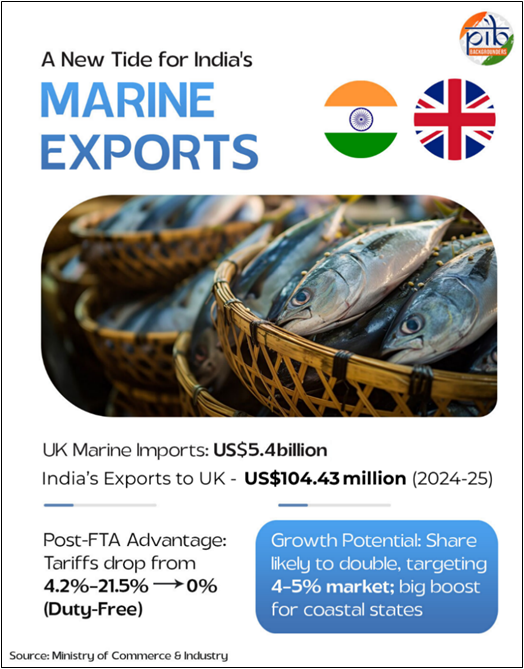
- The enhanced market access is expected to boost exports, which will directly benefit Indian fishermen of the Andhra Pradesh, Gujarat, Karnataka, Odisha, and Maharashtra. Overall, the CETA will not only strengthen India's fisheries exports but also contribute to the welfare and livelihoods of fishermen, promote coastal economic development, and enhance the competitiveness of the Indian fisheries sector on the global stage. Through this agreement, India strengthens not only its seafood exports but also its commitment to inclusive and equitable trade.
Forest Dwellers - Preserving Forests, Empowering Lives
- The CETA recognizes the importance of forests for providing livelihoods and job opportunities to forest dwellers and forest dependent communities. Such communities will benefit from the cooperative efforts taken by the Parties to promote sustainable forest management.
Workers - Better Jobs, Brighter Futures
- The immediate removal of duties on Indian products from labour-intensive sectors such as gems and jewellery, textiles, leather and footwear, and food processing will not only boost employment but also directly benefit Indian workers in these industries.
- The CETA offers a range of protections to workers by endorsing internationally recognized labour rights. Workers will benefit from increased public awareness of labour laws and access to impartial and independent tribunals and proceedings for the enforcement of their rights in an accessible and transparent manner. Women workers, in particular, will gain from provisions on non-discrimination and gender equality in the workplace.
- Additionally, the CETA will promote cooperative activities between the Parties that will enable capacity and skill development of workers.
- The CETA also provides enhanced market access for workers which include better mobility access to the UK for Indian workers engaged in maintenance and repair and tourist guides, among others. The CETA and its enhanced market access will create job opportunities for a wide range of workers across various sectors.
Women - Empowering Women Through Global Access
- The CETA marks a significant step forward in advancing opportunities for women and youth across both nations. It includes progressive provisions designed to break down barriers and promote greater participation in international trade, digital innovation, and government procurement for women, youth, and under-represented groups. By fostering cooperation on gender-responsive standards, sharing best practices in financial services, and improving digital inclusion, the CETA ensures that women business owners, entrepreneurs, and young professionals can access new markets, acquire valuable information, and participate equitably in global, regional, and domestic economies.
- Dedicated working groups under the CETA will promote activities that address discriminatory practices, encourage diversity, and further gender equality. This will empower women and youth to benefit from the opportunities and fair treatment, ensuring the advantages of the CETA are widely shared and inclusive.
Youth - Young Minds, Global Finds


- India’s youth from 15 to 29 years, comprising about 27.3% of its population, are driving social and economic transformation. The CETA is poised to expand high-quality employment pathways for Indian youth by easing services market access, securing mutual recognition of professional qualifications, and facilitating short-term mobility for talent in IT, healthcare, finance, and creative sectors. Lower tariffs on inputs and advanced manufacturing equipment can spur MSME supply-chain integration, creating skilled vocational jobs beyond metros. Overall, by fostering access to global value chains and enhancing competitiveness, CETA will empower Indian youth with essential skills and pathways to participate in international markets and future growth.
Small and Medium Enterprises (SMEs) – Local Hustle, Global Muscle
- SMEs are a vital part of India's economy, contributing around 30.1% of India's GDP in 2022-23 and 45.8% in India’s total export in 2024-25. SMEs benefit from various provisions of the CETA, including through provisions on faster processing at customs, agreements to recognise and facilitate digital systems and paperless trade, and a dedicated chapter to help SMEs. A contact point for SMEs will be established under the ambit of the CETA, facilitating communication and coordination benefiting SMEs.
- In addition to lower tariffs and better market access, SMEs will also benefit from the cooperation between India and the UK on best practices regarding trade education and finance, digital skills, business infrastructure and other important areas, facilitating business opportunities for SMEs. The Working Group on Government Procurement and on Innovation enable cooperation to address the issues of SMEs and facilitate participation in government procurement and innovation.
Businesses - From Local Roots to Global Routes
- Indian businesses will gain a lot from this CETA. Other than lower tariffs and market access for Indian goods and services, the CETA offers ease of doing business with the UK through simplified and streamlined customs and trade facilitation processes, from established systems like a Single Window and Authorised Economic Operator. Non-discriminatory treatment to Indian businesses and exporters, when it comes to goods, services and government procurement, benefits Indian businesses in the UK market.
- The CETA serves as a strategic catalyst for Indian enterprises operating within the UK, facilitating the optimal deployment of skilled personnel to deliver competitively benchmarked services aligned with UK market expectations. Prominent service sector entities, particularly in information technology with an established presence in the UK, stand to benefit from enhanced regulatory certainty regarding visa provisions for the assignment of Indian professionals. This framework is expected to strengthen bilateral economic ties and support the sustained growth of India’s services exports to the UK.
- Businesses will also benefit from the cooperative efforts enshrined in various chapters of the CETA, like the Innovation Working Group and cooperation on digital identities and trade, that will help promote connectivity, digital trade growth, collaboration on best practice principles and innovative opportunities; and responsible business conduction and corporate responsibility practices.
Professionals - Empowering Expertise, Enhancing Mobility
- Qualified professionals such as architects, engineers and medical professionals will be able to take advantage of the enhanced market access under the CETA and provide services in the UK. This is expected to create direct and indirect jobs through the expansion of service sectors. It also provides professionals with better mobility access to the UK. Independent professionals providing services such as R&D and computer services will be able to take advantage of these mobility commitments and provide their services in the UK. This will directly lead to job creation and better opportunities for a wide range of professionals, thereby increasing the quality of life.
- The benefit of CETA goes beyond the traditional services commitments. Indian chefs, yoga instructors and classical musicians up to a combined total of 1800 per year will now be able to temporarily move to the UK to provide their services.
- Additionally, around 75,000 detached workers will benefit from the Double Contribution Convention (DCC) which would come into force at the same time as the CETA. The DCC will exempt Indian workers who temporarily move to the UK and their employers from contributing to the National Insurance Contribution for three years. This will reduce the financial burden on Indian professionals temporarily working in the UK and will lead to better income generation.
- The trade deal also provides certainty for Indian professionals employed by companies without any physical presence in the UK who can now supply a service across key categories of services, including consulting, architectural services, tech, IT/ITes, travel agency, etc. The deal provides a guaranteed stay provision for certain categories such as investors, contractual service suppliers, etc., in line with the current visa norms for such professionals in the UK.
State-wise Benefits from India–UK CETA (Based on Export Potential)
- The India–UK Comprehensive Economic and Trade Agreement is expected to generate widespread opportunities across Indian states. Tariff eliminations and improved market access in the United Kingdom will enable significant export growth in key sectors, enhancing competitiveness and creating jobs at the regional level.
Following are the highlights of the anticipated economic benefits for major Indian states under the agreement:
|
State
|
Key Benefiting Sectors
|
Nature of Expected Benefit from UK Market Access
|
|
Maharashtra
|
Engineering goods,
Pharmaceuticals, Apparel
|
Higher exports of auto components, generic medicines, and garments from hubs like Pune, Mumbai, and Ichalkaranji
|
|
Gujarat
|
Pharmaceuticals, Chemicals, Engineering goods, Marine products
|
Boost to pharma exports (Ahmedabad), Chemicals (Surat & Bharuch), engineering (Rajkot), seafood (Veraval); MSMEs to benefit from easier UK access
|
|
Tamil Nadu
|
Textiles, Leather, Engineering goods
|
Major gains in apparel (Tiruppur), leather
(Vellore), auto parts (Chennai); improved price competitiveness in UK
|
|
Karnataka
|
Engineering goods, Electronics, Pharma
|
Bangalore-based machinery and electronics exporters to benefit; pharma units to expand exports
|
|
Andhra Pradesh
|
Marine products, Textiles
|
Substantial gains in shrimp and seafood exports
from Visakhapatnam and Kakinada; textile units in Guntur region to benefit
|
|
Odisha
|
Marine products, Handicrafts
|
Improved access for seafood from Paradip and Balasore; potential for traditional crafts in UK markets
|
|
Punjab
|
Textiles, Engineering goods
|
Textile exporters in Ludhiana and auto parts manufacturers to benefit from UK duty
elimination
|
|
West Bengal
|
Leather goods, Processed food, Tea
|
Exports of leather items (Kolkata), Darjeeling tea, and packaged food items to increase
|
|
Kerala
|
Marine products, Spices
|
Higher UK demand for shrimp, tuna and black pepper; exporters in Kochi and Alappuzha to gain
|
|
Rajasthan
|
Handicrafts, Gems & Jewellery
|
Exports of Jaipur’s jewellery and Jodhpur’s furniture and crafts to expand due to reduced tariffs
|
|
Delhi
|
Apparel, Engineering, Jewellery
|
MSMEs in Delhi NCR to gain from textile and
jewellery exports; improved access to UK retailers
|
Conclusion
The India–UK Comprehensive Economic and Trade Agreement marks a new chapter in the partnership between two dynamic economies. It goes beyond reducing tariffs to create a framework for cooperation in goods, services, investment, and innovation. With duty-free access on 99 per cent of tariff lines, the agreement opens doors for businesses, generates opportunities for workers and professionals, and ensures that growth is inclusive and sustainable.
By improving market access, promoting digital trade, and facilitating mobility, CETA lays the foundation for stronger supply chains and greater economic resilience. It also brings real benefits to consumers through better choices and competitive prices. Most importantly, it signals a shared commitment to deepening economic integration and unlocking the potential of a relationship built on trust and shared values.
CETA is not just a trade agreement. It is a strategic partnership for the future, creating pathways for prosperity for both nations and their people.
References:
Ministry of Commerce and Industry:
Click here to see PDF.
*****
RT/M
(Backgrounder ID: 154945)
Visitor Counter : 2371
Read this release in:
Hindi